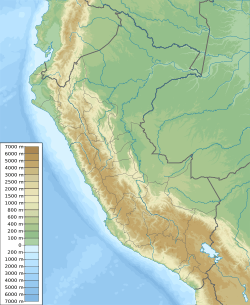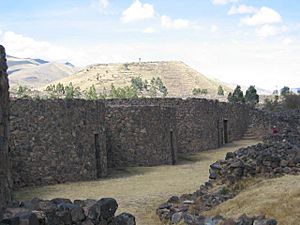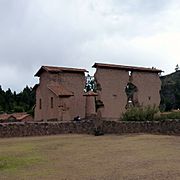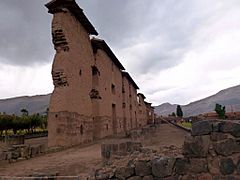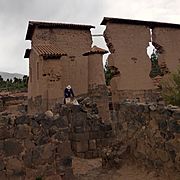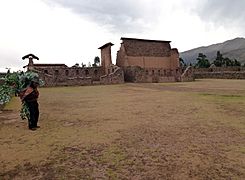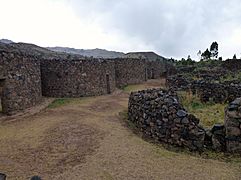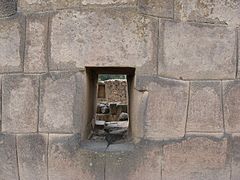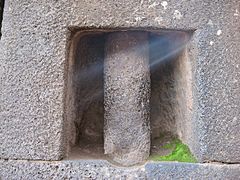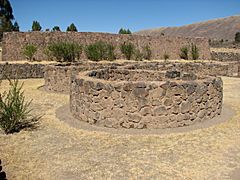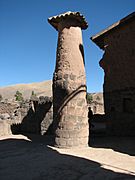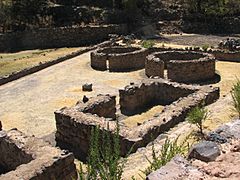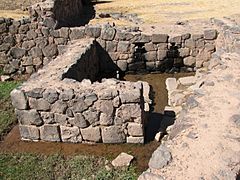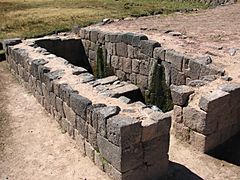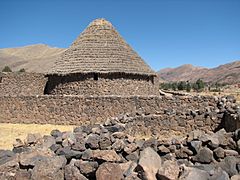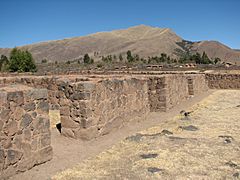Raqch'i facts for kids
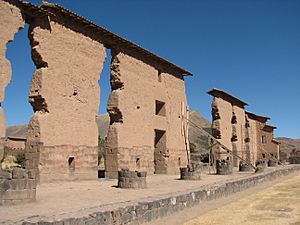
Central wall of the Temple of Wiracocha, the bases of the circular columns that in the past supported the roof of this Kallanka are still visible.
|
|
| Alternative name | Temple of Wiracocha, Temple of Viracocha at Chacha (Raqch'i) |
|---|---|
| Location | Peru, Cusco Region, Canchis Province |
| Region | Andes |
| Coordinates | 14°10′30″S 71°22′00″W / 14.17500°S 71.36667°W |
| Type | Settlement |
| Area | 10.97 km2 (4.24 sq mi) |
| History | |
| Cultures | Inca |
Raqch'i (pronounced Rahk-chee) is an amazing ancient site built by the Inca people in Peru. It's located high up in the mountains, about 3,480 meters (11,417 feet) above sea level. This makes it a very special place to visit.
Raqch'i is about 110 kilometers (68 miles) from the famous city of Cuzco. It sits near the Vilcanota River. Many people also call it the Temple of Wiracocha, which is one of its most important buildings. More and more tourists visit Raqch'i each year to explore its history.
Contents
Exploring the Raqch'i Site
The Inca site at Raqch'i was a very important spot on their ancient road system. This road started in Cusco and grew as the Inca Empire expanded. Raqch'i is in a valley known for its sacred places.
Most of the Inca buildings here are surrounded by a long wall, about 4 kilometers (2.5 miles) long. Just outside this wall, there's a group of eight rectangular buildings. These were likely a tampu, which was like a guesthouse for travelers.
The Raqch'i complex has many different areas, each with its own purpose. Some buildings might have been for religious leaders or government officials. Others think they could have been barracks to house soldiers, given the strong defenses.
Ancient Storehouses
Nearby, you can see about 220 round buildings. These were probably qullqas, which were huge storehouses. They held food and other goods. On the hillsides, there are also irrigated terraces. These were used to grow crops to keep the qullqas full for travelers.
Water and Rituals
Raqch'i also has a nearby spring and a pool or bath. These are close to the Temple of Wiracocha. They might have been used for special rituals. Some experts believe that because Raqch'i had both religious and administrative uses, the Sun cult might have kept llamas here for sacrifices. This was similar to another site called Mayobamba.
Strong Defenses
There's some proof that a village existed here before the Inca took over. However, it was the Inca who built the strong defenses for the city. Raqch'i is on a high ridge, which naturally protects it.
Just outside the main wall, there's a large dry moat. This ditch runs along the edge of the ridge. This, along with the steep slopes, shows that the Inca wanted Raqch'i to be extremely well protected.
The Temple of Wiracocha
The most impressive building at Raqch'i is the Temple of Wiracocha. It's a huge rectangular building that used to have a roof. It measures about 92 meters (302 feet) long and 25.5 meters (84 feet) wide.
This temple has a tall central wall made of adobe (mud bricks). This wall is about 18 to 20 meters (59 to 66 feet) high. Its base is made of strong andesite stone. There are windows and doors for people to pass through.
On each side of the central wall, there are eleven columns. The foundations of both the wall and the columns are made with classic high Inca stonework. The rest of the height was built using adobe.
A Giant Roof
Before the Spanish destroyed it, the temple had what is thought to be the largest single gable roof in the Inca Empire. This roof peaked at the central wall. Then it stretched over the columns and about 25 meters (82 feet) beyond on each side. The sheer size of this temple explains why the whole site is often called the Temple of Wiracocha.
Walking Through the Temple
The Temple of Wiracocha is special because we know how people were meant to walk through it. When you entered its two doorways, tall pillars immediately blocked your path. This forced visitors to walk around them in a zig-zag motion.
This design might have been on purpose. It could have been a way to show parts of Inca beliefs, especially their connection with Wiracocha. As people moved through the temple, they would have slowly made their way towards a statue of Viracocha, a volcano, and a spring.
The Legend of Wiracocha
According to Inca stories, Wiracocha came to a region the Inca called Kacha. But the local people didn't recognize him and tried to attack him. When Wiracocha saw this, he made fire fall from the sky. This fire burned the hills around the people.
The Kacha people begged Wiracocha for forgiveness. He put out the fires and told them who he was. They then built a wak'a (a sacred shrine) where Wiracocha had stood. They gave him many offerings there.
Later, the Inca ruler Huayna Capac passed by Kacha. He saw the wak'a shrine of Viracocha. The people told him about the miracle Wiracocha had performed. Huayna Capac decided that this event should be remembered even more. So, he ordered the great temple to be built.
Living Areas and Storehouses
Next to the temple, on its north side, are twelve living quarters. These likely housed both priests and local administrators. The living area is divided into separate square lots. The largest of these is about 4 by 6 meters (13 by 20 feet). All of them have special niches (small alcoves) in their walls. These might have been used for storage. Some niches even had cover posts, suggesting they held sacred objects.
Round Storehouses
On the eastern side of the temple, there are 152 round qullqas arranged in parallel lines. Each of these storehouses is about 10 meters (33 feet) in diameter. These qullqas were used to store grains like corn and quinoa. They also held pottery, woven cloth, and military equipment. These round storehouses are unique because most other Inca buildings are square. We don't know why these were built round.
The Sacred Qucha
The Qucha (which means "lake" in Quechua) is an artificial lake at Raqch'i. It's fed by a spring through two beautifully built stone fountains. There's also a raised platform next to one of them.
This lake is a main feature of the site. Both the temple and the raised platform overlook it. The two fountains are similar to those the Inca used in cleansing rituals and for making offerings.
Archaeologists found a deep layer of ash between the northern fountain and the raised platform. This ash might be the remains of burnt offerings. It was possibly stored before being put into the qucha and washing into the Willkanuta River.
In Inca beliefs, springs were often seen as sacred. The spring at Raqch'i, with its fountains, might have been thought of as the origin place of the K'ana people. These people are mentioned in the legend of Viracocha.
The Legend of the Spring
One legend says that after Viracocha caused fire to fall from the sky, he left the people. Then the rivers dried up. The people prayed and started to die from thirst. Viracocha then appeared before them in a white robe, holding a staff. He pushed his staff into the volcanic rock, and water began to flow. This spring is considered very sacred, providing life-giving water.
Fairground and Baths
To the west of the temple is a large field. Locals now use it for farming. This area might have been a fairground or a place for extra worshipers from the temple. On the far western edge of this field, there are baths. These are similar to ceremonial baths found at other important Inca sites.
Gallery
See also
 In Spanish: Racchi para niños
In Spanish: Racchi para niños
- Kimsachata
- List of archaeological sites in Peru


